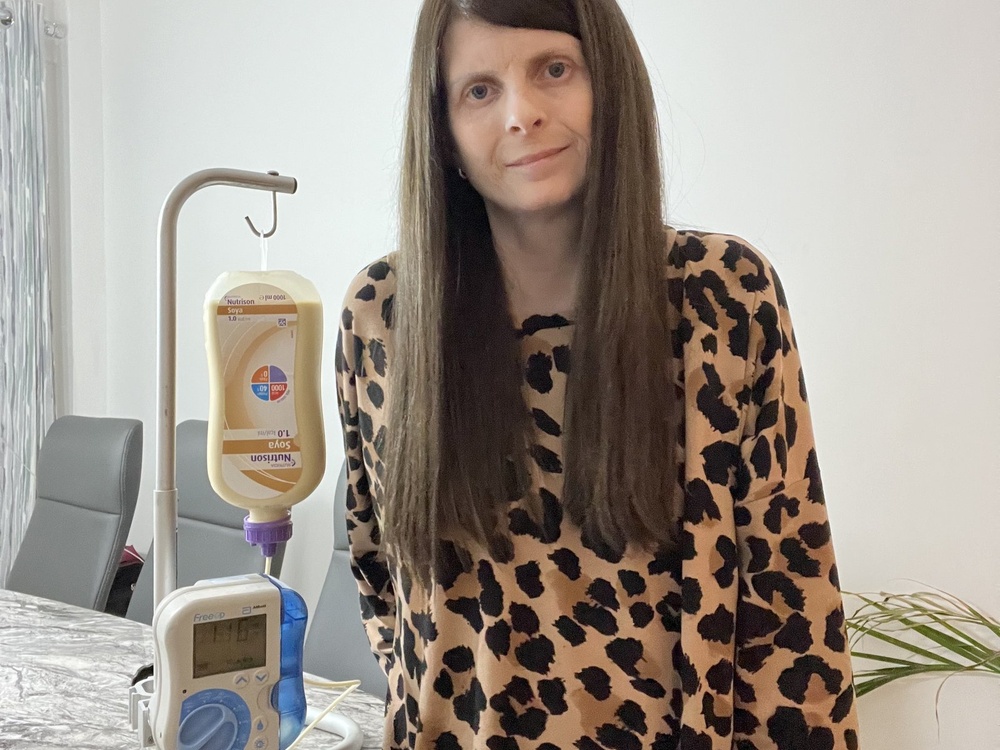Danielle, now 36, spent decades battling eating problems, misdiagnoses and a healthcare system that failed to identify the root cause of her health struggles. Finally, three years ago, she was diagnosed with mitochondrial disease. For Danielle, this diagnosis brought clarity to a lifetime of health complications.
One solution has truly changed her life: a feeding tube.
A difficult start
From birth, Danielle faced severe feeding issues. Unable to keep food down, she was fitted with an NG (naso-gastric) tube as a baby. She wore the tube intermittently until she hit school age, and while it helped her gain weight, it didn’t address her other health issues.
“I still had other health problems which I feel like it disguised,” she reflects. “I stopped wearing it as soon as I went to school – I think my mum was worried that I might get picked on. Also I remember in the hospital once being held down by four or five people to get the tube in because I must’ve not wanted it. That might be another reason why she didn’t want me to keep it.”
Between the ages of 5 and 16, she took growth hormones, but weight gain remained a challenge. During her teenage years, repeated hospital admissions for dehydration became a regular cycle. “I’d perk up with fluids, go home, and then end up back in hospital,” she recalls. “That happened regularly, right into my twenties.”
Misdiagnosis: the eating disorder assumption
Doctors repeatedly misdiagnosed Danielle with anorexia nervosa. Her preference for ‘beige foods’ like toast, crisps and noodles led to admissions to several eating disorder facilities.
“I wonder now if it was a sensory thing. I would go through fads, find a ‘safe’ food I really liked and stick to it. I remember being 16 and living off chips and coleslaw from the local takeaway for a year. I still go there today,” she chuckles, “it’s just down the road! I didn’t think about calories, I never felt hungry, and I could go for days without eating. I was probably really nutritionally deficient.”
Danielle finally got some answers when she was diagnosed with gastroparesis, a condition where food moves slowly through the stomach, causing discomfort and lack of appetite. This diagnosis paved the way for a feeding tube to become part of her treatment.
The decision to get a feeding tube
Danielle resisted an NG tube for years due to that past trauma. However, in 2014, her health deteriorated, and her doctor insisted she couldn’t leave the hospital until she gained weight.
“Finally I agreed to have a tube,” Danielle admits. “This time it went in fine but I didn’t like the feel of it down my throat. I didn’t like the idea of people looking at me either. I got picked on at school, and this was just another thing to draw attention to me.” Despite her fears, she persevered and gained weight.
Eventually, doctors recommended a PEG (percutaneous endoscopic gastronomy) tube, which delivers nutrients directly into the stomach. Though the initial placement was painful, the PEG tube became a turning point in Danielle’s care.
A life transformed by a simple device
Danielle stayed in hospital for a couple of days and was shown how to administer her own feed. “I did it overnight. And then I gained over six kilos in three months, thanks in part to the feeding tube. I was eating too. Not loads, but a bit more than usual. And physically I felt ok.”
She had the PEG tube for just over a year before having it changed for a button, although that too was a disturbing experience for Danielle. “They sedated me because I was scared, but I could still feel them yanking and tugging at it,” she winces. “But it’s much better having a button, although I still hate getting it changed, which happens twice a year.”
Despite this, having the feeding tube has changed Danielle’s life. “It’s the best thing ever,” she states. “It was such a relief when they gave it to me – finally I was getting the right treatment. If they’d given me one back when I was 18 I could’ve avoided so much unnecessary trauma.”
It’s also meant her weight has stopped being the main focus for her doctors. “I hate my weight being such a big deal to people,” she explains. “I feel like my whole life’s been about my weight and I don’t want it to be.”
Feeding tubes: simple yet life-saving
For Danielle, the feeding tube has been nothing short of life-saving. “It’s made a massive difference to my life, both physically and mentally,” she admits. “If I hadn’t had it, I might have died. I’d probably still be going through the same cycle of ending up in hospital, gaining weight and coming back out again. That probably would’ve gone on forever.”
And Danielle’s definitely an advocate of a feeding tube these days, particularly for those who don’t necessarily want other people to know. “If anyone is struggling to eat or gain weight or stay well, it will help you out, and if it’s at night it’s great. I don’t normally talk about mine. But I would recommend having one because I think it’s so good to not feel that pressure of having to eat.”
Feeding Tube Awareness Week highlights the vital role feeding tubes play in supporting those with medical conditions like mitochondrial disease. Danielle hopes her story will encourage others to see feeding tubes as a lifeline, not a limitation.
“It’s not been without its challenges,” she admits. “But in the long run, it’s been worth it. This tiny device has given me a second chance at life.”

